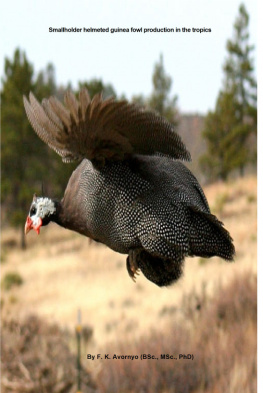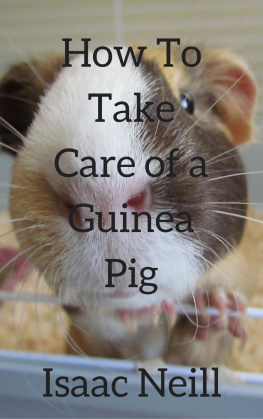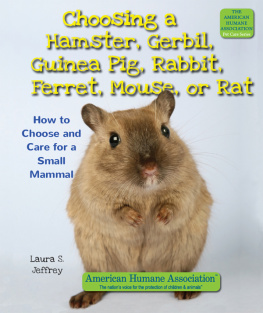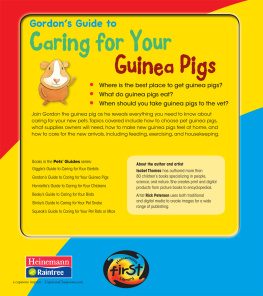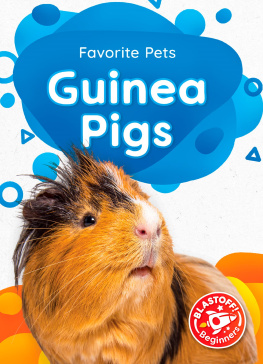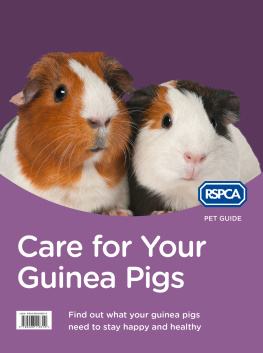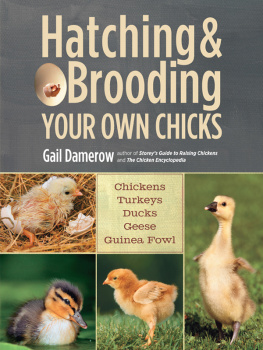Smallholder helmeted guinea fowl production in thetropics
By F. K. Avornyo (BSc., MSc., PhD)
Council for Scientific and Industrial Research -Animal Research Institute, Nyankpala Station, Tamale, Ghana
Copyright 2017 F. K. Avornyo
All rights reserved.
Distributed by Smashwords
This ebook is licensed for your personal enjoymentonly. This ebook may not be re-sold or given away to other people.If you would like to share this ebook with another person, pleasepurchase an additional copy for each person you share it with. Ifyoure reading this book and did not purchase it, or it was notpurchased for your use only, then you should return toSmashwords.com and purchase your own copy. Thank you for respectingthe hard work of this author.
Ebook formatting by www.ebooklaunch.com
Table of Contents
Getting started
Some people probably have interest inrearing guinea fowls. They may already have been rearing guineafowls for many years and may already be keeping a few guinea fowls.Others may be complete starters. Whatever their needs may be, it ishoped that they would find some useful information that would helpthem succeed in guinea fowl rearing. Whatever their situation mightbe, if they are considering rearing guinea fowls, there are a fewthings they have to do.
There is the need to identify a place torear them. This may be in a community or away from humansettlement. They may be reared under the intensive system, on freerange or under the semi-intensive system. If local breeds would beused, then it might advisable to keep them under the intensivesystem for the first six to eight weeks followed by the free rangesystem for the rest of their lives but they should be trained tosleep in their coops overnight. If exotic guinea fowls would bekept, then they might be maintained under the intensive system. Itmay however be difficult to make any profit under the intensivesystem considering that most people in developing countries wouldnot have the capacity to keep over 10,000 guinea fowls at atime.
If the intention is to produce large numbersof guinea fowls, then it would be advisable to undertake such aventure in the outskirts of town. This however has its challenges.The problem of snakes killing them may be encountered. Anotherpossible threat is theft. Guinea fowl house may be sited at alocation where theft is not common. There may be the need to engagea caretaker to keep watch over the birds. Brooding of keets may bedone in ones house or community and the keets later transferredwhen they are six to eight weeks old to the site earmarked forrearing of growers and adults.
If the guinea fowl house is located close tothe road, vehicles may run over the guinea fowls, unless they aremaintained under the intensive system. However, the intensivesystem may not be advisable if management skills are low. It may bedifficult to rear a large number of guinea fowls within thecommunity since there might be problems with space. Moreover,guinea fowls destroy seedlings and this may bring about conflict inthe community. Advice on site selection may be sought fromsuccessful guinea fowl farmers. The selected site should not getflooded in the rainy season and it should also be free oflitigation.
Acquisition of inputs
After choosing a suitable site, there wouldbe the need for a building to be constructed. Further discussion onbuilding can be found in the Chapter on Housing. There would be theneed to buy a few thermometers. If hens are not available forincubation of eggs, there may be the need to buy an incubator. Ifthere is electric power source, then an electric incubator may bepurchased. However, if there is no electricity in the locality,then a kerosene incubator may be purchased. A few incandescentlamps need to be purchased in the absence of gas brooders; ten 100W incandescent lamps for brooding 300 guinea keets, a generator,fuel for the generator and wood shavings. Three sacks full of woodshavings may just be enough for a room measuring 3 m by 3 m. Ifrice husk is used as litter for newly hatched keets, the keets maysuffer paralysis. For a kerosene incubator, kerosene should bebought. For people with electricity, the guinea fowl house shouldbe connected to a power source especially where brooding would bedone. A few electrical extension cables need to be acquired.Fertile guinea fowl eggs should be acquired as well as feed andwater troughs. Only a few small-sized feed and water troughs shouldbe bought for the first week of brooding. Bigger ones that cancontain more feed and water should also be acquired so as to avoidpurchasing many small ones when a few large ones might help savesome money. In the absence of electricity and a gas brooder, a fewAwudu heaters may be used. An Awudu heater is an assembly of claypots containing burning charcoal. One or two Awudu heaters maygenerate enough heat for 300 keets. For the Awudu heater, somecharcoal, a lighter, a fan and some kerosene may be needed. It maynot be advisable to use lantern especially for very young keetsbecause of the smoke and the smell of kerosene. Local stove mayalso pose danger to keets. Burning Liquefied Petroleum Gas (LPG) isa good source of heat. It may be used together with an Awudu heaterand electric lamps.
There may be the need for large transparentpolythene sheets. These may be used to wrap round the brooderfacility to keep the place warm for young keets. A few 1 inch nailsmay be needed to nail the polythene sheets to the brooder facility.Other items that may be needed include a good disinfectant,measuring cup, glucose with vitamin C, a good mineral-vitaminsupplement, a good antibiotic, special guinea fowl dewormer, acoccidiostat and empty sacks. To be on the safer side, arrangementsshould be made to vaccinate keets against gumboro, New Castledisease and fowl pox. Balanced feed may be bought or prepared forkeets. Each unimproved keet may require about 2 kg of feed fromhatch to 8 weeks old. Afterwards grains may be obtained and usedfor supplementary feeding for the rest of the rearing period.
Table 1: A list of inputs that may be required forsuccessful guinea fowl rearing (This example is for raising 600unimproved keets)
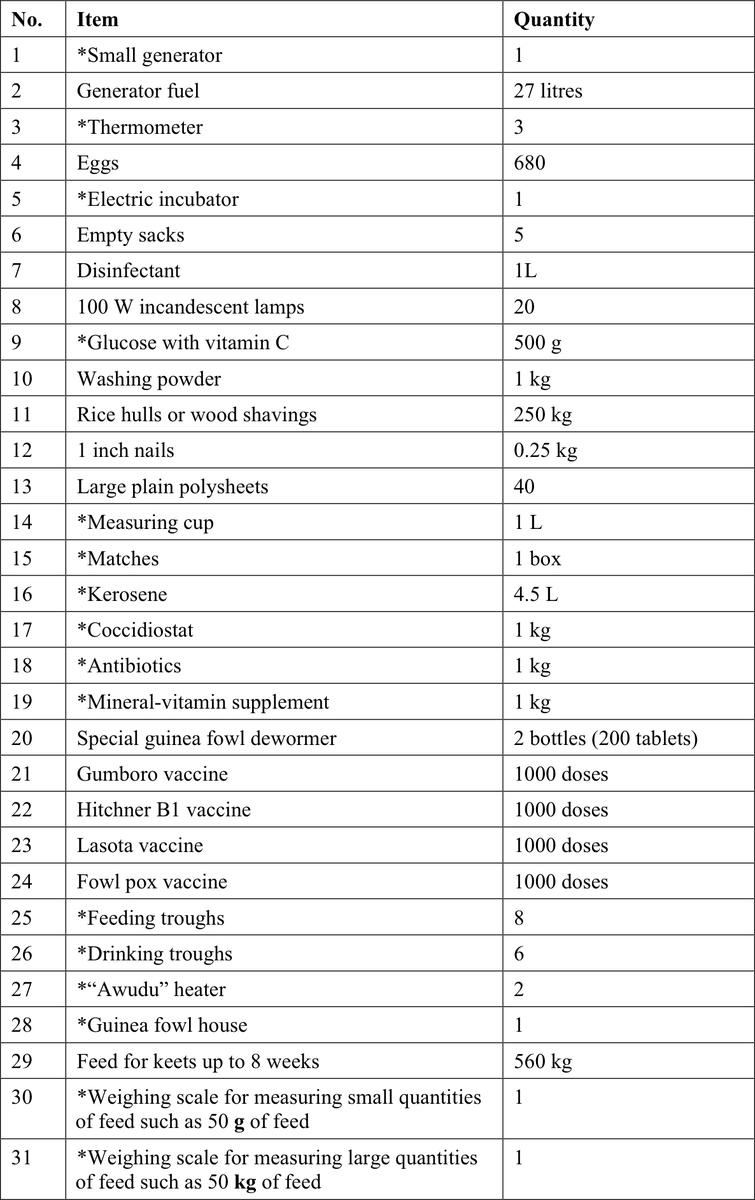
*Some of these materials can be used againand again. Excludes supplementary feeding cost from grower to adultstage.
Housing
It is a good practice to house guineas bothwhen they are young and also as adults. One structure can beconstructed and partitioned into two so that one side will serve tobrood young ones and other side can be used for housing growers andadults at night. If possible the housing for young ones can becompletely separated from that for the adults because the old birdscan easily transmit diseases to young ones if the houses are closeto each other.
Brooder and adult houses should be built insuch a way that when the wind is blowing, it would get to thebrooder house first before going to the adult house. If it is notin this way, the wind may blow diseases from the adult house intothe brooder house. This may be dangerous for the enterprise. Alsothe building should be properly sealed so that moles, snakes andother predators do not get access to attack guinea fowls inside thehouse. Houses should be constructed in the east-west direction sothat the sun and wind will apparently move along the length of thebuilding rather than the breadth of the building. However, there isalso the need for enough sunlight to enter the building so thatinside the room is not completely dark. A brooder house may looklike a normal building for human beings with windows and doors tomatch the length of the building. Keets below 4 weeks of age do nottolerate draught well so if possible the rooms for very young keets(less than 3 weeks) should have only a door but no window to admitdraught which may contribute to keet mortality. House for growersand adults may look like a shed with a short wall and hangingroofs. There should be wire netting to cover the space between thewall and the roof. For adult and grower guinea fowl house, wiremesh with slightly bigger holes may be used. Once guinea fowlscannot pass through or get stuck in the wire mesh, it is okay. Asimilar structure may be used even for brooding of young birds,however, the wire mesh should be very small otherwise keets maysqueeze through it. For brooding purposes, the mesh should becovered with large transparent polythene sheets round the buildingfor about three weeks from the period of hatch.

